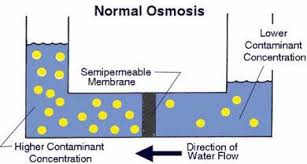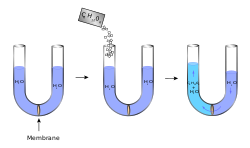WHAT OSMOSIS IS- DEFINITION & PROCESS
DEFINITION
- Osmosis is the movement of a solvent across a semipermeable membrane from a region of lower concentration of solution toward a higher concentration of solution.
- In biological systems, the solvent is typically water, but osmosis can occur in other liquids, and even gases.
IMPORTANT POINTS
- Semi permeable membrane (SPM) – It is such type of membrane through which solvent= water passes, but solute don’t pass. Plasma or cell membrane is a SPM.
- Differentially or Selectively permeable membrane- In such type of membrane some particles pass whereas others don’t pass, e.g. lipo-protein cell membrane.
- The term “Osmosis” was coined by Abbe Nollel.
- It is a specific type of diffusion of liquids, wherein water (solvent) passes from a region of higher concentration to a region of lower concentration. In biological systems, the solvent is typically water.
- Osmosis provides the primary means by which water is transported into and out of cells.
- Osmosis is a vital process in biological systems, as biological membranes are semipermeable. These membranes are impermeable to large molecules, such as ions, proteins, and polysaccharides, whereas permeable to lipids as well as to small molecules like oxygen, carbon dioxide, nitrogen etc.
- Plant roots draw water from the soil through osmosis. Plants concentrate solutes in their root cells by active transport, and water enters the roots by osmosis. Osmosis is also responsible for controlling the movement of guard cells.

OSMOTIC PRESSURE/OSMOTIC POTENTIAL
- It is the pressure which is required to be applied to a solution to prevent the inward flow of its pure solvent or stop osmosis across a semipermeable membrane.
- Osmotic potential is used by modern physiologist now due to several definitions of osmotic pressure. Osmotic potential is that part of water potential which becomes more negative with addition of solutes.

Thus osmotic potential = Negative osmotic potential. It means osmotic potential indicates decrease in pressure due to addition of the solutes. In a pure solvent, the value of osmotic potential is zero (0) which is maximum value.
Read more…
DIFFERENCE BETWEEN PLANT CELL AND ANIMAL CELL
DIFFERENCE BETWEEN PROKARYOTIC AND EUKARYOTIC CELLS
CELL STRUCTURE AND FUNCTION
WHAT IS ENZYME- NATURE AND PROPERTIES
CLASSIFICATION OF ENZYMES
REPRODUCTION IN PLANTS